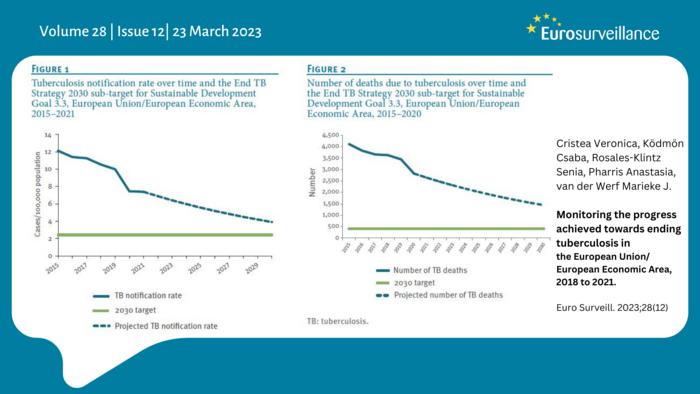The United Nation’s Sustainable Development Goals (SDG) set the target of ending tuberculosis (TB) as a global public health threat by 2030. [1] Based on the most recent surveillance data published by the European Centre for Disease Prevention and Control (ECDC) and the World Health Organization (WHO) Regional Office for Europe, the overall TB incidence in the 30 countries of the European Union/European Economic Area (EU/EEA) is low: the majority (24) of countries reported less than 10 TB cases per 100,000 population in 2021. [2]
In their rapid communication in Eurosurveillance, Cristea et al. assessed the possibility of reaching agreed goals based on current progress towards the SDG target for TB as well as global and regional targets for the EU/EEA associated with them.
Setting a baseline: 80% reduction in TB incidence
What does the SDG TB target translate into? According to the WHO End TB Strategy, countries need to reach an 80% reduction in TB incidence compared with the 2015 baseline. For the EU/EEA countries, this means a notification rate of 2.4 per 100,000 population across the region by 2030.
The EU/EEA overall is on a good path with a reported average annual decline in TB incidence of 6.8% between 2015 and 2021. At this pace, however, the TB notification rate by 2030 would be 3.9 per 100,000 population, i.e. higher than the set target. Cristea et al. estimate that an annual decline of 11.7% from 2022 onwards is needed in the EU/EEA to reach the incidence target of 2.4 per 100,000 population in 2030.

Credit: Eurosurveillance
The United Nation’s Sustainable Development Goals (SDG) set the target of ending tuberculosis (TB) as a global public health threat by 2030. [1] Based on the most recent surveillance data published by the European Centre for Disease Prevention and Control (ECDC) and the World Health Organization (WHO) Regional Office for Europe, the overall TB incidence in the 30 countries of the European Union/European Economic Area (EU/EEA) is low: the majority (24) of countries reported less than 10 TB cases per 100,000 population in 2021. [2]
In their rapid communication in Eurosurveillance, Cristea et al. assessed the possibility of reaching agreed goals based on current progress towards the SDG target for TB as well as global and regional targets for the EU/EEA associated with them.
Setting a baseline: 80% reduction in TB incidence
What does the SDG TB target translate into? According to the WHO End TB Strategy, countries need to reach an 80% reduction in TB incidence compared with the 2015 baseline. For the EU/EEA countries, this means a notification rate of 2.4 per 100,000 population across the region by 2030.
The EU/EEA overall is on a good path with a reported average annual decline in TB incidence of 6.8% between 2015 and 2021. At this pace, however, the TB notification rate by 2030 would be 3.9 per 100,000 population, i.e. higher than the set target. Cristea et al. estimate that an annual decline of 11.7% from 2022 onwards is needed in the EU/EEA to reach the incidence target of 2.4 per 100,000 population in 2030.
Similarly, the target of 411 TB-related deaths per year by 2030 would require an annual average decline of 17.5% – when 2,821 TB deaths were registered in 2020. According to the ECDC TB experts, the current annual decline rate of 6.5% across the EU/EEA would lead to a total of 1,441 TB deaths in 2030.
Based on their data analysis, the authors conclude that at this stage, “the current observed average annual declines of 6.8% and 6.5%, respectively, in the number of TB cases and TB deaths are not sufficient to reach the SDG targets for TB by 2030.”
They acknowledge that efforts in prevention, control and surveillance of TB have been impacted by the COVID‑19 pandemic and the related response measures. But “to achieve the Regional and global targets, specific actions are needed such as increasing case finding and TB preventive treatment, and people-centred approaches to support people with multidrug-resistant TB in completing treatment. Furthermore, improved availability of shorter and all-oral treatment regimens for drug-susceptible and MDR TB can lead to improved treatment initiation and outcomes.”
Ways forward
In a joint editorial the same Eurosurveillance issue, ECDC Director Andrea Ammon and the Director of the WHO Regional Office for Europe, Hans Kluge, urge that “to get back on track, we need revitalised and urgent political and financial commitment, and an agile and adapted response to TB. We also need to handle new challenges and threats proactively.” [3]
They list new tools that can support the TB response in Europe: the shortened, injection-free treatment regimens for multidrug- or rifampin resistant TB of 6 months instead of 18 or more, new rapid molecular diagnostics, digital health solutions and innovative service-delivery approaches.
However, Ammon and Kluge conclude that “to truly end TB, we must interrupt transmission by finding people with active TB before they infect others and prevent those already infected from developing the disease. TB-preventive treatment remains the main public health intervention and top priority for elimination.”
—-Ends—-
References/notes to editors:
[1] Target 3.3 as part of goal 3 on ‘Good Health and Well-Being. United Nations (UN). Goals: 3. Ensure healthy lives and promote well-being for all at all ages. New York: United Nations. Available from: https://sdgs.un.org/goals/goal3
[2] European Centre for Disease Prevention and Control (ECDC), World Health Organization Regional Office for Europe. (WHO/Europe). Tuberculosis surveillance and monitoring in Europe 2023 – 2021 data. Copenhagen: WHO/Europe and Stockholm: ECDC; 2023.
Available from: https://www.ecdc.europa.eu/en/publications-data/tuberculosis-surveillance-and-monitoring-europe-2023
[3] Ammon A, Kluge H. Ending tuberculosis in Europe – resetting the course in the post-COVID-19 era. Euro Surveill. 2023;28(12):2300164
Available from: https://www.eurosurveillance.org/content/10.2807/1560-7917.ES.2023.28.12.2300164
[4] The World Health Organization (WHO) launched the first World Tuberculosis Day on 24 March 1982, one hundred years after Dr Robert Koch announced the discovery of Mycobacterium tuberculosis, the bacteria that cause TB.
Further TB articles in Eurosurveillance, marking World TB Day 2023:
Guthmann JP, Fraisse P, Bonnet I, Robert J. Active tuberculosis screening among the displaced population fleeing Ukraine, France, February to October 2022. Euro Surveill. 2023;28(12):2300155. 10.2807/1560-7917.ES.2023.28.12.2300155
Martínez-Lirola M, Herranz M, Buenestado Serrano S, Rodríguez-Grande C, Dominguez Inarra E, Garrido-Cárdenas JA, et al. A One Health approach revealed the long-term role of Mycobacterium caprae as the hidden cause of human tuberculosis in a region of Spain, 2003 to 2022. Euro Surveill. 2023;28(12):2200852. 10.2807/1560-7917.ES.2023.28.12.2200852
Journal
Eurosurveillance
DOI
10.2807/1560-7917.ES.2023.28.12.2300154
Method of Research
Data/statistical analysis
Article Title
Monitoring the progress achieved towards ending tuberculosis in the European Union/European Economic Area, 2018 to 2021
Article Publication Date
23-Mar-2023
COI Statement
None declared




